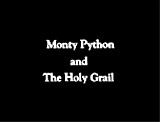
|
Monty Python and the Holy
Grail (1975, UK)
In directors Terry Gilliam and Terry Jones'
irreverent popular, and outrageous second Monty Python feature-length
film (but the first with original material) - it was a raucous,
innovative, anarchic retelling of the Middle Ages legend of King
Arthur (Graham Chapman) and his quest; it
skewered religion, medieval action epics, mythology, war, religion,
film subtitles, the Middle Ages and the Arthurian legend, costume
pictures, the witch trials and black plague, the mythical and heroic
quest for the Holy Grail in the 10th Century AD, Camelot and
a host of other topics.
The silly, chaotic, unconventional, sick joke-filled
and zany Monty Python troupe, a close modern equivalent to the Marx
Brothers, first appeared in their BBC-TV show from 1969-1974, Monty
Python's Flying Circus, composed of a series of unrelated sketches.
Afterwards, the group compiled a retelling of the show's first two
years of sketches for the big screen in their first feature film
- And Now For Something Completely Different (1971).
On a budget of about $410,000, the unusual comedy grossed about $2.8 million (worldwide). Many cult fans of the film
can instantly recite many of the memorable scenes, vignettes and
set-pieces, such as the "Bring
Out Your Dead" scene, or the rude, taunting Frenchman at the
castle, the bloodthirsty Killer Rabbit, or the tree-shaped Knights
who said "Ni."
- the opening credits of this original cult
film slowly gave way to mock Swedish titles, and then drifted into
ravings about visiting Sweden to see its virtues (including the
country's Moose) before grinding to a halt with the statement:
- "We apologize for the fault in the subtitles.
Those responsible have been sacked."
- the opening credits resumed, but still with
odd credits added for everything from "Moose Costumes" to "Moose
trained to mix concrete and sign complicated insurance forms," which
was followed by another apology:
- "The directors of the firm
hired to continue the credits after the other people had been
sacked, wish it to be known that they have just been sacked.
The credits have been completed in an entirely different style
at great expense and at the last minute."
- after several false starts, the film opened in the
year 932 A.D.; wearing a crown, chain mail, and a tunic, King
Arthur (Graham Chapman) was traveling in the foggy countryside,
searching for gallant men to join his Knights of the Round Table;
he was viewed galloping over a grassy hill - with an imaginary
stallion (announced by the clopping sound of approaching hooves
on cobblestones!); next to the King was his hunchbacked squire
or servant-lackey Patsy (Terry Gilliam) banging two half-coconut
shells together to simulate the horses' hooves - an old-fashioned
sound effect
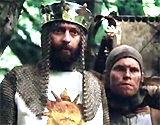
|

|
|
King Arthur (Graham Chapman) with Patsy (Terry
Gilliam) Simulating Galloping on a Horse
|
- a ridiculous argument ensued between King
Arthur and others about the coconuts that Patsy had in his
possession; the King argued that Patsy's coconuts were carried
to England (or Mercia) (to the more temperate Northern zone)
by an African swallow, not by a European swallow:
- "It's a simple question of weight
ratios. A five-ounce bird could not carry a one-pound
coconut...In order to maintain air speed velocity,
a swallow needs to beat its wings 43 times every second...It
could be carried by an African swallow. An African
swallow, maybe, but not a European swallow...But then,
of course, African swallows are non-migratory. So they
couldn't bring a coconut back anyway. Wait a minute.
Supposing two swallows carried it together!"
- in an outrageous village scene where the Black
Plague had hit hard, corpses were collected (for nine-pence apiece)
by the Dead Collector (Eric Idle) on his rounds with a cart through
a muddy medieval village; he struck a triangle as he cried out: "Bring
Out Your Dead!"; he entered into an argument with a elderly
bearded peasant (John Cleese) who had a half-dead body of a decrepit
man slung over his shoulder - the man struggled and kept insisting:
("I'm
not dead!...I don't want to go on the cart"); after a long series
of arguments, the Dead Collector finally gave in, knocked the half-dead
man in the head with a stick and killed him
- the Monty Python style of humor was best exemplified
by the comically-gruesome encounter between King Arthur with an
unbelievably persistent and fearsome Black Knight (John Cleese) who
behaved insolently after killing another armored opponent; after
not answering to Arthur's invitation to join his court, the Black
Knight spoke out: "None shall pass!"; he refused to let
Arthur and Patsy cross a bridge over a small gully; the Black Knight
persisted and insisted on fighting an epic battle; even after all
of his limbs had been hacked off by King Arthur, the Black Knight
wouldn't accept defeat:
- "It's just a flesh wound!...I'm
invincible!... The Black Knight always triumphs!...I see. Running
away, eh? You yellow bastards! Come back here and take what's
coming to you! I'll bite your legs off!"
- remarkably, the Black Knight didn't expire at the
end of the scene, even though the Black Knight was reduced to only
a head and torso; the duel ended in a tie when the Knight asserted: "All
right, we'll call it a draw."
|
Mutilation of The Black Knight: "All right,
we'll call it a draw"
|
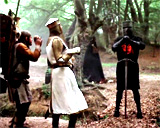
|
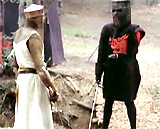
|
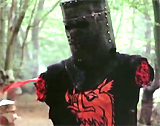
|
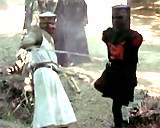
|

|

|
- Arthur also observed a witch trial, in which a suspected
witch (Connie Booth) was being prosecuted and questioned and threatened
with being burned for no good reason, except for the way she was
dressed, and for the testimony of a peasant (John Cleese): (Question: "What
makes you think she's a witch?" Answer: "She turned me
into a newt!...I got better!"); Sir
Bedevere the Wise (Terry Jones) proposed a method to determine if
the crone was a witch or not, with factors including buoyancy and
flammability; the witch's weight was compared with the weight of
a duck, and found to be guilty; the non-sensical argument was made
that witches could burn just like wood (or ducks) that also floated
in water; therefore, because the suspected witch
weighed at least as much as a duck, she was therefore made of wood
and hence a witch:
- "So logically, if she weighs the same as
a duck, she's made of wood. And therefore? A witch!"
- continuing on his quest, King Arthur had already recruited
Sir Bedevere the Wise, and added others including Sir Lancelot
the Brave (John Cleese), Sir Galahad the Pure (Michael Palin) or "The
Chaste,"
Sir Robin the Not-Quite-So-Brave-as-Sir-Lancelot (Eric Idle), and
the Sir Not-Appearing-in-this-Film (a baby (William Palin)), along
with their squires and Robin's minstrels
- the group of Knights riding along with King Arthur
spotted the castle Camelot in the distance; (Patsy downplayed the
sight: "It's only a model!" King
Arthur: "Shh!"); several knights performed the loopy,
anarchic "Camelot Song (Knights of the Round Table)" about
their lives as Knights of the Round Table - inside the castle; the
song featured high-kicking, helmeted knights dancing in a chorus line,
and tap dancing; after the number was
concluded, King Arthur (now back on the outskirts of the castle with
his knights) memorably reconsidered and sighed: "Well, on second thought,
let's not go to Camelot. It is a silly place"; as he turned away in despair,
he saw a miraculous (animated) vision
of the Almighty God in the clouds, urging him to go forth and find the
Holy Grail
- at a French-controlled castle, a mustached French
sentry (John Cleese) taunted the "daffy English knights" and spoke
insulting words to King Arthur from the castle wall:
- "I fart in your general direction! Your mother
was a hamster and your father smelt of elderberries."
- angered by the taunting Frenchman and other enemy
soldiers who falsely claimed that they already had the Grail, the
Knights prepared to attack the low-walled castle with swords, until
they were repelled by the Frenchmen launching a catapulted cow and
other livestock at them; Sir Bedevere instigated a plan to gain entry
into the French enemy's castle by sneaking in using a giant wooden
Trojan Rabbit, but his plan failed when he absent-mindedly neglected
to tell the Knights to hide inside; the Rabbit structure was
thrown back at the group of Knights, and crushed one of the servants
- in a surprising
scene prefaced by the snapping of a movie clapboard, a modern-day historian
named Frank (John Young), who was commenting on the Arthurian legend
and the King's progress during the filming of a documentary, suddenly
and viciously was slashed to death across the neck with a sword by
an un-named horseback-riding knight (the master of the Black Knight?),
the main unidentified villain in the film; afterwards, the man's
wife (Rita Davies) (from off-camera) rushed to her dead husband's
side, crying out: "Frank!"; a police investigation was
opened and pursued, and it was theorized
that it was possible that the killer Knight (who was not with Arthur)
was framing Arthur and his Knights for murder
- after the Knights split up into separate groups, one
of Sir Robin's minstrels traveling with him in a forest graphically
bragged about his leader's brave penis, they were confronted by
a three-headed Giant (Terry Jones, Graham Chapman, and Michael Palin);
the three heads of the Giant began to bicker amongst themselves,
causing them to become distracted from their goal of fighting
against the legendary Robin - who they eventually noticed had already
left their presence
- meanwhile on their quest for the Grail, Sir Galahad
and his followers entered Castle Anthrax (with a grail-shaped beacon)
that they found was populated by young female teens in robes; Galahad
was encouraged by one of the leaders, Dingo (Carol Cleveland) to
engage in sexual punishments directed at most of the inhabitants
of the castle, but he was unwillingly "rescued" from getting involved
by his companions; the group of knights left the castle and a trio
of frustrated girls (Elspeth Cameron, Mitsuko Forstater, and Sandy
Rose)
- in a hut, Arthur and Sir Bedevere asked an elusive,
cackling old man (bridgekeeper) (Terry Gilliam) about the location
of the Grail, who eventually disappeared after mentioning an Enchanter
and a Bridge of Death
- they came upon a helmeted, dreaded
towering 12-foot tall Leader Knight (Michael Palin) with deer antlers
sticking up from his head, surrounded by his animal-like, tree-shaped
followers known as the Knights who say 'Ni' (Sandy Johnson); the intimidating,
eccentric lead Knight made strong but strange coercive demands of
Arthur, and claimed that his Knights could only be appeased (and
allowed passage through) with gifts of two shrubs and the cutting
of the largest tree of the forest with a herring: ("One
that looks nice... and not too expensive"); later in the tale,
Arthur's men bought one shrubbery from Roger the Shrubber (Eric Idle)
in a nearby village, but then when they returned, they were allowed
entry by frightening their adversaries with their secret dreaded word - "It"
- during a harsh winter and year, the Knights were forced
to eat Sir Robin's minstrels due to starvation; after being reunited,
the Knights spoke with gray-bearded Tim the Enchanter
(John Cleese) with horns on his head, who demonstrated the power to
create and command fire (pyrokinesis); as he directed them
to the entrance of a cave, where they believed the directions to
the Grail might be located written on an interior wall; he spoke
of a terrible monster, identified as the guardian beast of the cave
- the Fierce Killer Rabbit of Caerbannog (that only looked like a
harmless white rabbit): ("It's just a harmless little bunny,
isn't it?")
- to gain entry to the cave, the Knights attacked, but the Rabbit viciously
fought back, jumped up and beheaded Sir Bors (Terry Gilliam) with
a single bite to the neck; Arthur retaliated by ritualistically acquiring the "Holy
Hand Grenade of Antioch" (a sacred relic) provided by the nearby
Brother Maynard, to blow up and destroy the Rabbit; they first consulted
with the religious order's Book of Arnaments, reading long passages
from verses 9-21 about how to deploy the weapon:
- "And Saint Attila
raised the hand grenade up on high, saying, 'O Lord, bless this
thy hand grenade, that with it thou mayst blow thine enemies
to tiny bits, in thy mercy.' And the Lord did grin. And the people
did feast upon the lambs and sloths, and carp and anchovies,
and orangutans and breakfast cereals, and fruit-bats and large
chu...First shalt thou take out the Holy Pin. Then shalt thou
count to three, no more, no less. Three shall be the number thou
shalt count, and the number of the counting shall be three. Four
shalt thou not count, neither count thou two, excepting that
thou then proceed to three. Five is right out. Once the number
three, being the third number, be reached, then lobbest thou
thy Holy Hand Grenade of Antioch towards thy foe, who, being
naughty in my sight, shall snuff it.'"
- after conquering and destroying the Rabbit with an
explosive hand grenade, they entered the inside of the cave where
they read the Aramaic script by Joseph of Arimathea on the wall that
directed them to the Castle Aaaaarrrrrrggghhh (in France) to find
the Grail; but then, the Knights were ambushed by a gigantic, ugly
green cave monster (animated) mis-named as the "Legendary
Black Beast of Aaaaargghh" that devoured Brother Maynard; as the
monster pursued the fleeing knights (also animated), they were saved
when the beast's Animator (Terry Gilliam) unexpectedly died of a heart
attack
- the knights came up to the guarded, decrepit-looking,
almost-collapsed, rope-constructed Bridge of Death crossing, where a trollish, creepy
soothsayer / bridgekeeper (Terry Gilliam) from earlier asked the
travelers five (or three) questions before they were allowed to pass
over the Gorge of Eternal Peril; if they answered wrongly or didn't
know an answer, they suffered a horrible fate; Lancelot easily passed
the test (he answered that his favorite color was blue) and proceeded
over the bridge, but Sir Robin failed to answer his trick question:
("What is the capital of Assyria?"), and Sir Galahad also failed
(he said his favorite color was also blue although it was actually
yellow), and both were magically cast into the deadly Gorge; King
Arthur was the 4th to be questioned; he was asked: "What is the airspeed
velocity of an unladen swallow?"; when Arthur demanded a clarification
about whether the swallow was African or European, the bridgekeeper
failed to answer his question, and he was magically thrown into the
Gorge; the fifth and last knight Sir Bedevere crossed over the Bridge
of Death without having to answer any more questions
- in the plot-twisting conclusion, the police had already
begun to investigate the strange murder of historian Frank; Arthur
and his last remaining knight Sir Bedevere took a monster-headed
barge across a lake back to the French-occupied Castle
Aarrgh; they were expelled by the same taunting and insolent Frenchman
from earlier who catapulted a sheep at them, and then human excrement;
Arthur and Bedevere were forced to retreat across the lake, seemingly
relinquishing their plan to storm the castle
- on the other side of the lake, however, Arthur was
able to assemble (out of thin air) and command 1,000s of foot soldiers
who suddenly appeared on a ridge; Arthur ordered his well-equipped
troops to charge at the castle; as the military forces surged forward, a
modern-day police car, a paddy wagon, and officers of the law pulled
into the scene in front of King Arthur's large battle army
- Frank's widowed wife (Rita Davies) exited the car
and mistakenly shouted out at King Arthur and Bedevere: "Yes,
they're the ones, I'm sure" - the group of insane knights were
arrested by the authorities for the murder of her husband - historian
Frank; one of the police officers threatened the cameraman, and put
his hand over the camera lens: ("All
right, sonny, that's enough, just pack that in") - but after
the cameraman swore: "Christ!", the film reel broke in
the projector and derailed from the gate and the film abruptly ended
 |
 |
 |
|
Frank's Wife: "Yes, they're the ones, I'm
sure"
|
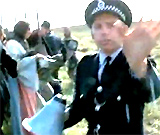
|
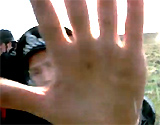
|
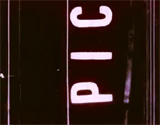
|
|
The Abrupt End of the Film
|
|

The Collection of Corpses in a Village During the Plague: "Bring
Out Your Dead"
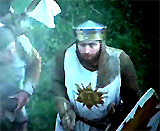
King Arthur Arguing About How Coconuts Were Carried to
England
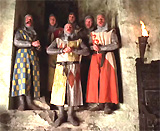
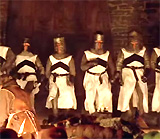
Chorus Line in "Camelot Song (Knights of the Round
Table)"

King Arthur Gathering Knights to Join Him

An Animated Vision of God Urging King Arthur To Not Give Up His
Quest to Find the Holy Grail (A Holy Cup)
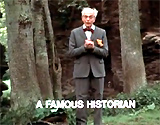
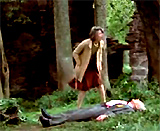
The Unexpected Murder of an Historian by a Villainous,
Unnamed Knight

The Knights Who Say 'Ni' - Not Allowing Passage Unless
They Could Be Appeased With Shrubbery
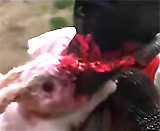
The Killer Rabbit Biting the Neck of a Knight and Beheading Him
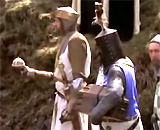
King Arthur's Ritualistic Throwing of the Holy Hand Grenade
to Destroy the Killer Rabbit

Bridgekeeper Questions For the Knights at The Bridge of Death to Allow
Passage Over the Deadly Gorge

Plot-Twist Ending: Arrests of the Knights by the Police
- Who Suspected Them of Murdering Historian Frank
|














